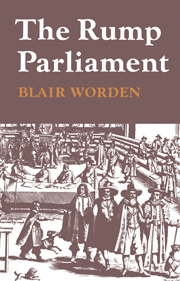Book contents
- Frontmatter
- Contents
- Dedication
- Acknowledgements
- Author's Note
- List of abbreviations
- Introduction
- PART ONE THE RUMP AND THE RUMPERS
- 1 Membership, attendance and allegiance
- 2 The limits of revolution
- 3 Moderation and conformity
- 4 Soldiers and clergymen
- 5 Commitment and corruption
- PART TWO THE RUMP AND REFORM
- PART THREE THE STRUGGLE FOR SURVIVAL, FEBRUARY 1649–SEPTEMBER 1651
- PART FOUR PARLIAMENT versus THE ARMY, SEPTEMBER 1651–APRIL 1653
- PART FIVE THE DISSOLUTION OF THE RUMP
- APPENDICES
- Bibliographical Guide
- Index
4 - Soldiers and clergymen
Published online by Cambridge University Press: 29 January 2010
- Frontmatter
- Contents
- Dedication
- Acknowledgements
- Author's Note
- List of abbreviations
- Introduction
- PART ONE THE RUMP AND THE RUMPERS
- 1 Membership, attendance and allegiance
- 2 The limits of revolution
- 3 Moderation and conformity
- 4 Soldiers and clergymen
- 5 Commitment and corruption
- PART TWO THE RUMP AND REFORM
- PART THREE THE STRUGGLE FOR SURVIVAL, FEBRUARY 1649–SEPTEMBER 1651
- PART FOUR PARLIAMENT versus THE ARMY, SEPTEMBER 1651–APRIL 1653
- PART FIVE THE DISSOLUTION OF THE RUMP
- APPENDICES
- Bibliographical Guide
- Index
Summary
Cromwell, although preeminent among the army leaders when he chose to be, did not become Lord General until June 1650, when Fairfax resigned his command rather than lead an army into Scotland. Fairfax, admitted to the Rump with his fellow army officer Nathaniel Rich after a disputed election, seems never to have taken his seat. Opposed to the purge and the execution, he, like so many others, remained at his post as long as he felt able to moderate the revolution's course. Other army officers who took their seats in the Rump included Richard Ingoldsby, a regicide who rarely attended the House, Philip Skippon, who played a central role in Pride's Purge but who was nevertheless always one of the more moderate army leaders, and Charles Fleetwood, a ‘conformist’ who enjoyed Cromwell's confidence. More important were two other army M.P.s, Henry Ireton and Thomas Harrison, who had provided the radical initiative in the Council of Officers in the autumn of 1648. In December and January both men underwent changes of mind, with profound consequences for the character of the Commonwealth regime.
Harrison, later to emerge as the leader of the Fifth Monarchists and as the focus of the army's most radical aspirations, had in November 1648 been as anxious as anyone to dissolve the Long Parliament, if necessary by force. Yet, at the height of the crisis between the purge and the execution, he acknowledged that the day of the saints had not yet dawned, and conceded that power must remain in the hands of the existing parliament.
- Type
- Chapter
- Information
- The Rump Parliament 1648–53 , pp. 74 - 85Publisher: Cambridge University PressPrint publication year: 1974

